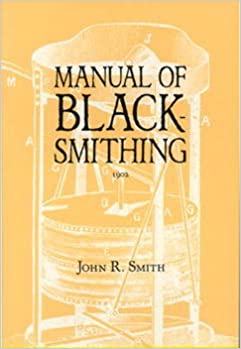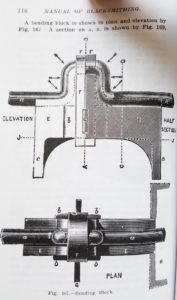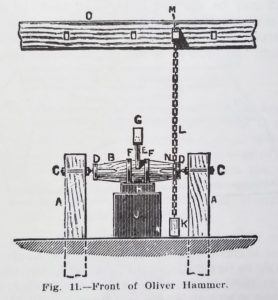By: John R. Smith – Published 1902

Price : $ – Amazon
Philip’s Ranking: 3
Beginner Blacksmith: 2
Advanced Blacksmith: 2
Inspiration: 2
Historical: 4
Video Review: N/A
Written in 1902 John Smiths Manual of Blacksmithing was written for full time blacksmiths providing instruction on the common tools, techniques, and projects of the day.
Unlike many of the books of this period John seems to have been engaged in more industrial blacksmithing rather than country/farm blacksmithing. As an example chapter 8 is focused on the forging of cranks, model work, and die forging. If you are a modern smith 12 pages on how to forge crank shafts out of wrought iron are probably not the most useful when you are looking for guidance on projects. On the other hand if you are trying to restore or recreate old machinery this book will provide a lot of detail around industrial blacksmithing at the turn of the twentieth century.
probably not the most useful when you are looking for guidance on projects. On the other hand if you are trying to restore or recreate old machinery this book will provide a lot of detail around industrial blacksmithing at the turn of the twentieth century.
It is important to keep in mind when reading this book that many of the techniques and facts presented in the book are no longer true, largely because of the move from wrought iron to mild steel as the standard forging medium. Much of the instruction in the book have callouts about how to ensure the fibrous grain structure of wrought iron is aligned with the the direction of the highest forces on the object. For example in the crank pictured to the left it’s mentioned how bending the crank produces a stronger crank as the fibers move through the crank shaft in a continuous end to end “stream” as opposed to cutting it out of of a larger section of wrought iron where the fibers would be lying next to each other.

That example highlights both the joy of this book and it’s greatest caution. If you are a new smith you can’t read this book and assume the information in it is accurate because of changes in materials, technology, or science has advanced considerably. If you already have a solid grasp of the modern fundamentals of blacksmithing it’s easy enough to know what should be disregarded and the changes are an interesting look at the history of how our craft has changed.
One of my favorite parts of the book is the introduction where plans are provided for handy shop tools such as adjustable support tools, Oliver hammers, and various bending and leveling jigs. Since the level of mass production and industrialization was much lower in 1902 than today most of these tools are reproducible by even a hobby smith in their garage today.
Overall I think this is a great book for anyone who is specifically interested in early 1900s blacksmithing in an industrial setting. There is a lot of great information in the book and it’s a valuable resource to understand the work a blacksmith at that time was doing.